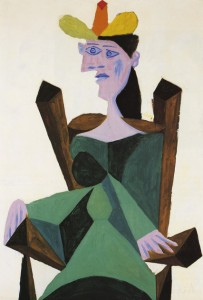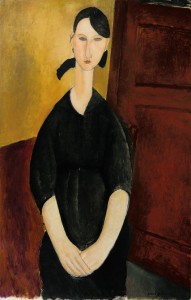
Pablo Picasso’s “Femme Assise sur une Chaise,” 1938, is estimated to sell for $25 million to $35 million.
Credit
2015 Estate of Pablo Picasso/Artists Rights Society (ARS), New York, via Sotheby’s
The New York Times reports that Sotheby’s first auction of the late A. Alfred Taubman’s art collection will be Nov. 4. Christie’s tried to win the auction rights, but lost. It would have looked bad if Christie’s had won. Taubman was Sotheby’s “principal owner” for 22 years. The collection is expected to generate a raft of money, perhaps $500 million, possibly the biggest private haul ever. There are big names in it — Rothko, Raphael, Picasso and Modigliani.
The Times noted that Taubman died in April at the age of 91, and that he was a philanthropist and shopping mall magnate. I did not know Taubman, but I have reason to dislike him. It has nothing to do with the fact that he wound up in the slammer for nine and a half months for price fixing while in charge of Sotheby’s. He was convicted in a U.S. court while his Christie’s counterpart, also accused of bilking buyers, was in England, above and beyond extradition.
In the 1980s, awash in cash, Taubman decided he fancied the St. Louis Post-Dispatch, a relatively modest family enterprise owned by the descendants of Joseph Pulitzer, journalism’s giant and pioneer. Besides the Post, the family owned broadcast properties, The Arizona Daily Star and some small publications. I worked for, and reported directly to, Joseph Pulitzer’s grandson, Michael Edgar Pulitzer, who then served as editor and publisher of the Star. Michael’s half-brother, Joseph Pulitzer III, was editor and publisher of the Post-Dispatch.

Amedeo Modigliani’s “Portrait de Paulette Jourdain,” circa 1919, also estimated to bring $25 million to $35 million.
Credit
Sotheby’s
Taubman’s assault on Pulitzer publishing involved a segment of the family that was not satisfied with dividends and was unable according to the trust to cash in its shares at market value. Thus Taubman offered $500 million for the company with the dissenting family members offering 43 percent of the company. The dissidents were paid off when the Joseph and Michael and the rest of the majority shareholders decided to take the business public. The initial public offering (IPO) generated enough cash to pay off the dissidents.
But the nature and character of the enterprise changed drastically. It became public corporation with a singular responsibility to serve shareholder interests above all. As a family company, it had paternal bent, and money was not the be all and end all.
Thus, Taubman’s hostile takeover effort came to naught. Instead, Pulitzer Inc. was born. It died in 2005 with the sale of the company to Lee Enterprises. By then, Joseph Pulitzer III was long dead and Michael Pulitzer headed the company and guided the sale. The company had tripled in value over Taubman’s offer. The sale took place at the peak of the company’s value. Two years later and the value of the company probably would not have been half. Lee Enterprises carries today a market cap value of $112 million and still owes $745 milliion from its Pulitzer purchase 10 years ago. The debt from that purchase has been an enormous yoke.
I cannot dislike Taubman a lot. The corporatization of newspapers was a trend long before he asserted himself into the takeover fray. If I wax nostalgic, so be it. Newspapers became great when they were owned by individuals whose families considered it wise and necessary to uphold tradition, at least until love of money got in the way. The only way I see for them to rediscover greatness again is with that same ownership by individuals who love newspapering and the excitement it creates serving the public good and its First Amendment responsibility.
Recent Comments